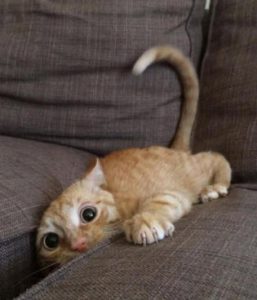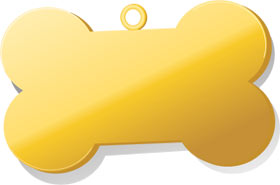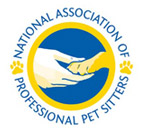Do you ever wonder what your cat is thinking? Well, cats have their own way of communicating their feelings. For instance, I have two cats. Fred (mostly) uses his tail to let me know how he feels. But Stumpy is a lot more vocal. His “meow” or “purr” will give me insight on how he might be feeling that day.
own way of communicating their feelings. For instance, I have two cats. Fred (mostly) uses his tail to let me know how he feels. But Stumpy is a lot more vocal. His “meow” or “purr” will give me insight on how he might be feeling that day.
Watch the Tail
The cat’s tail will show a myriad of emotions. When the tail is straight up, the cat is showing friendliness. When his tail is straight up and quivering, your cat is extremely happy (unless he’s not fixed and is trying to spray to mark his territory). If his tail is straight at a slight angle, waving, he’s being amicable, but isn’t much interested in the person or object. If his tail is gently swinging (that’s Fred), he’s usually content unless his ears are back, then he might be showing you mild irritation. If his tail is flicking, he’s interested in something (slow flicking) or showing irritation (rapid flicking).
If a cat’s tail is straight and downward with little to no movement, he’s showing aggression and is ready to fight. He could also be showing aggression towards a toy or prey. If his tail is wildly thrashing rapidly, he’s showing anger or irritation. And finally, if the cat’s tail is tucked under or flat against its legs, he’s showing submission. It could also mean he’s fearful and may run away if he feels cornered.
Watch the Ears
The placement of a cat’s ears is also significant to determining his emotions. They’re not as expressive as the tail but together with tail movement, you’ll get a wider picture of what your cat is thinking.
If your cat’s ears are back, you can bet he’s showing aggression. If the ears are up and back, he’s confidently aggressive and is ready to challenge his object. This can be seen during play or toward other rival cats. The more the ears become flattened back and down, the more fearful of the situation the cat is.
If his ears are sticking out, he’s showing extreme unhappiness or mild fear. But the more the ears go back, the more the cat is feeling threatened and will act accordingly.
Affectionate Behaviors
My cat, Stumpy, vocalizes. A quick purr or chirp usually means he’s greeting you. Even a growl, accompanied by a purr shows contentment and affection as you’re stroking him.
If you’re a cat person, you know all about kneading. If a cat kneads you, he’s showing complete happiness and that he’s relaxed and content where he is.
Pressing with its head and rubbing your leg with his face, also shows affection. He’s actually transferring his scent to you to reinforce the bond that you share. If he rubs around your legs, it’s another way for him to share scent and to display affection. Your cat may also display this kind of affection towards other cats, dogs or members of your household.

















Speak Your Mind